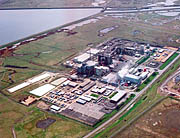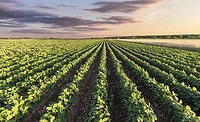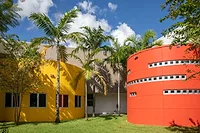A Bright Outlook

That's the message conveyed by Rob Louw, a top Huntsman Tioxide executive at the company's headquarters complex in Billingham, U.K., who discussed recent developments and future prospects for the world's number-three TiO2 supplier during a recent interview.
Louw, senior vice president, Commercial, said that under Huntsman ownership, Tioxide is "looking to grow the business. That's a definite change from the previous ownership." ICI, by contrast, had made it clear before the sale of Tioxide that it was hitching its future prospects to specialty chemicals and coatings, and would jettison its basic and commodity chemicals holdings such as TiO2 maker Tioxide.
Huntsman, meanwhile, offers no apologies about its embrace of basic-chemicals businesses such as TiO2. Salt Lake City-based Huntsman, a privately held concern located far from the whims of Wall Street, apparently sees such old-economy industries as solid investments. Huntsman paid approximately $2.8 billion in acquiring Tioxide and ICI's polyurethanes units, along with petrochemical holdings in mid-1999.
Since then, Huntsman has embarked on a number of growth initiatives for Tioxide that, while not seismic in scale, certainly demonstrate that Huntsman views TiO2 as a valuable asset in its chemicals portfolio.
Making the biggest wave, of course, was the company's announcement a little more than a year ago that it would conduct a feasibility study to weigh the possibility of building a 50,000-metric-ton-per-year TiO2 plant in China based on the company's ICON technology. Since then, Louw said Tioxide has evaluated a number of possible plant sites and continues to examine factors such as cost, economic-growth trends in the Asia-Pacific region, and the risks inherent in investing in major production capacity in China.
"It's not if, it's when," Louw said of prospects for the Chinese TiO2 plant. At this point, however, Tioxide is also considering expansion opportunities in Europe and North America, he said.
Actually, China's domestic economy is only one piece of the puzzle when gauging the drift of the economic winds in the Asia-Pacific region, Louw is quick to point out. China has continued to register strong growth numbers in recent years, but "other economies are not doing so well," he observes.
Meanwhile, Tioxide is busy elsewhere in the region, expanding the capacity of its TiO2 plant in Malaysia to 56,000 metric tons (mt) per year. Tioxide currently supplies Asia-Pacific customers from that plant and with exports from Europe.
Other Tioxide sites are seeing expansion, as well. At the company's Greatham Works, near Hartlepool, U.K., Tioxide is building a new "ICON" production facility that is scheduled to begin operation next year. The plant will bring the site's total TiO2 capacity to 100,000 mt/year, a gain of 20,000 mt from existing capacity. The new facility will be the second ICON plant at the Greatham works, joining a unit that went into production in 1989 and has been upgraded since then. Another unit at the site, which employs "much older technology," will be decommissioned when the second ICON unit goes into operation next year, Louw said.
When the new plant is completed, Louw said the Greatham works will surpass the company's Huelva, Spain, production site as the company's lowest-cost TiO2 operation. The Huelva site also is getting an upgrade, as Tioxide expands output there by 17,000 mt, to 94,000 mt/year, with the additional capacity due to begin operation in 2003.
Tioxide's ICON technology was developed in the mid-1980s and, Louw said, is "unique to Tioxide as we are the only TiO2 producer to operate a plasma-based integrated chlorination and oxidation unit" - hence the name ICON. The technology, combined with other advances, make the Greatham ICON plant one of the most highly competitive facilities in the world in terms of cost effectiveness, Louw said. "The plant is very reliable and also produces world-class quality pigments," he said. The ICON system has been installed only at the Greatham works, but will be employed at all new Tioxide production sites, he said.
Tioxide says the expansions in the U.K. and Spain will strengthen the company's position as the top TiO2 producer in Europe. Huntsman Tioxide President and CEO Peter R. Huntsman, in announcing the most recent expansion - at the Huelva site - said the upgrade is "a further demonstration of our commitment to the titanium dioxide industry and to our customers." The project and other expansions reflect the company's move to "further globalize our business," he said.
Douglas Coombs, Huntsman Tioxide president, said the company "is moving fast with targeted, competitive expansions which will significantly reinforce our ability to serve our customers."
In North America, Louw said, production also has increased at the Lake Charles, LA, TiO2 plant operated jointly by Tioxide and Kronos Inc. in a 50-50 joint venture. The site currently produces nearly 140 mt per year.
Since the acquisition by Huntsman, Louw said Tioxide's total production has risen slightly, going from 520,000 mt per year to around 540,000 mt currently. But with the additional capacity upgrades under way, the company is poised to take advantage of stronger economic growth in the world's key economies - growth that the experts are forecasting to arrive late this year and in 2002.
Louw said Tioxide is currently forecasting that TiO2 prices will remain soft in Europe for the remainder of this year, with strengthening anticipated in the first half of next year, reflecting expectations of stronger economic growth and a better showing by the euro. In the United States, a pickup in the economy - and thus stronger TiO2 demand - is anticipated to arrive in the fourth quarter of this year, with Asia expected to follow suit shortly afterward.
"Obviously this year is not a good year, but in relative terms, we're doing a lot better than we have in the past" during such economic troughs, he said. "Despite the downturn, the company (Huntsman) is investing in us.
"The important thing is to try to sustain investments to take advantage of when things do improve."
Regarding the challenges posed by the coatings market, Louw said Tioxide is seeking to ensure optimal product attributes by focusing on coatings applications at certain production sites. A case in point is the company's site in France, which is totally dedicated to making coatings grades. The company's Greatham and Lake Charles sites also primarily manufacture coatings grades.
The introduction of new TiO2 grades occurs only slightly more often than the Chicago Cubs win the World Series, but Louw said Tioxide will soon roll out a new, durable TiO2 grade in Asia and Africa. The product will offer a sulfate-process counterpart to a chloride-process grade that is already available, he said.
Louw said Tioxide is focused on "delivering the product on time every time, and on spec," ensuring product consistency, and providing product attributes geared to specific end uses.
Offering some perspective on Tioxide, post-acquisition, Louw said ownership by Huntsman has provided a boost. "It's helped us to have strong ownership. It has enabled us to grow again," he said. Huntsman has essentially taken a hands-off approach to the business, allowing Tioxide's management to continue programs to improve customer service and expand product offerings while striving to improve competitiveness.
"Huntsman leaves it up to Tioxide management to run the business," he said, "as long as we deliver."
Looking for a reprint of this article?
From high-res PDFs to custom plaques, order your copy today!








